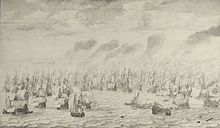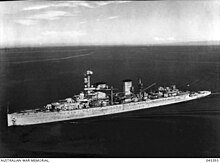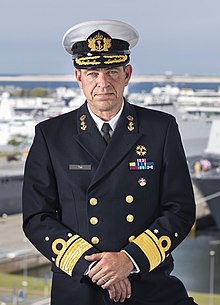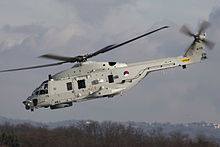
A | B | C | D | E | F | G | H | CH | I | J | K | L | M | N | O | P | Q | R | S | T | U | V | W | X | Y | Z | 0 | 1 | 2 | 3 | 4 | 5 | 6 | 7 | 8 | 9
| Royal Netherlands Navy | |
|---|---|
| Koninklijke Marine | |
 Emblem of the Royal Netherlands Navy | |
| Founded | 8 January 1488 |
| Country | |
| Type | Navy |
| Size | 7,508 active military personnel (2021)[1]
19 helicopters: NH90 NFH |
| Part of | Netherlands Armed Forces |
| Headquarters | Den Helder |
| Motto(s) | Veiligheid op en vanuit zee Security on and from the sea. |
| March | Defileermars der Koninklijke Marine (Royal Netherlands Navy Service Marchpast) |
| Engagements | Eighty Years' War Dutch–Portuguese War Anglo-Dutch Wars War of the Spanish Succession War of the Quadruple Alliance French Revolutionary Wars World War II Indonesian National Revolution Korean War Battle of Arafura Sea |
| Commanders | |
| Commander | Vice-Admiral René Tas |
| Deputy commander | Rear admiral Huub Hulsker |
| Notable commanders | Michiel de Ruyter, Piet Hein, Maarten Tromp |
| Insignia | |
| Flag |  |
| Naval ensign |  |
| Naval jack |  |
| Pennant | |
| Logo | |
| Aircraft flown | |
| Patrol | NH90 NFH |
The Royal Netherlands Navy (Dutch: Koninklijke Marine) is the maritime service branch of the Netherlands Armed Forces.[2][3] It was founded on 8 January 1488,[4] making it the third-oldest naval force in the world.
During the 17th century, the navy of the Dutch Republic (1581–1795) was one of the most powerful naval forces in the world and played an active role in the Anglo-Dutch Wars, the Franco-Dutch War, and wars against Spain and several other European powers. The Batavian Navy of the later Batavian Republic (1795–1806) and Kingdom of Holland (1806–1810) played an active role in the Napoleonic Wars, though mostly dominated by French interests.
After the establishment of the modern Kingdom of the Netherlands, it served an important role in protecting Dutch colonial rule, especially in Southeast Asia, and would play a minor role in World War II, especially against the Imperial Japanese Navy. Since World War II, the Royal Netherlands Navy has taken part in expeditionary peacekeeping operations. It often participates in European Union and NATO operations.
Ship prefixes
An international prefix for ships of the Royal Netherlands Navy is HNLMS (His/Her Netherlands Majesty's Ship).[5][better source needed] The Netherlands navy itself uses the prefixes Zr.Ms. (Dutch: Zijner Majesteits, lit. 'His Majesty's') when a King is on the throne, and Hr.Ms. (Dutch: Harer Majesteits, lit. 'Her Majesty's') when there is a Queen. This happens automatically at end of the monarch's reign.[6]
History
The modern Netherlands Navy dates its founding to a "statute of admiralty" issued by Maximilian, King of the Romans and his son Philip the Fair, the ruler of Burgundian lands (a minor at that time) on 8 January 1488.[7][a]
Netherlands Golden Age

The Netherlands navy was involved in several wars against other European powers from the late 16th century, initially for independence against Spain in European waters, later for shipping lanes, trade and colonies in many parts of the world, notably in four Anglo-Dutch wars against England. During the 17th century the Dutch navy was one of the most powerful navies in the world. As an organization, the navy of the Dutch Republic consisted of five separate admiralties (three of them in Holland, and one each in Friesland and Zeeland), each with its own ships, personnel, shipyards, command structures and revenues.[8]
World War II


At the start of WW2 the Dutch had five cruisers, eight destroyers, 24 submarines, and smaller vessels, along with 50 aircraft. The Netherlands was conquered in 1940 by Nazi Germany in a matter of days, and two Dutch light cruisers and one destroyer leader and three destroyers that were under construction were captured in their shipyard.
For the rest of the war, the Dutch navy was based in Allied countries: the Dutch navy had its headquarters in London, and smaller units in Ceylon (modern day Sri Lanka) and Western Australia. Around the world Dutch naval units were responsible for transporting troops, for example during Operation Dynamo at Dunkirk and on D-Day, they escorted convoys and attacked enemy targets. Dutch submarines scored some victories, including one on a Kriegsmarine U-boat U-95 in the Mediterranean Sea, which was sunk by O 21, but during the war the Dutch Navy suffered heavy losses, particularly in the Pacific Theatre.
A small force of submarines based in Western Australia sank more Japanese ships in the first weeks after Japan joined the war than the entire British and American navies together during the same period, an exploit which earned Admiral Helfrich the nickname "Ship-a-day Helfrich".[9] The aggressive pace of operations against the Japanese was a contributing factor to both the heavy losses sustained and the greater number of successes scored as compared to the British and Americans in the region.
But during the relentless Japanese offensive of February through April 1942 in the Dutch East Indies, the Dutch navy in Asia was virtually annihilated, particularly in the Battle of the Java Sea (27 February 1942) in which the commander, Karel Doorman, went down with his fleet along with 1,000 sailors. The Navy sustained losses of a total of 20 ships (including two of its three light cruisers) and 2,500 sailors killed in the course of the campaign.[10] The Dutch navy had suffered from years of underfunding and came ill-prepared to face an enemy with more and heavier ships with better weapons, including the Long Lance-torpedo, with which the cruiser Haguro sank the light cruiser HNLMS De Ruyter.[11]
Netherlands New Guinea
After the war, the relations between the Netherlands and its colonies changed dramatically. The establishment of the Republic of Indonesia, two days after the Japanese surrender, thwarted the Dutch plans for restoring colonial authority. After four years of conflict the Netherlands acknowledged the independence of Indonesia.
Part of the Dutch Navy was next stationed in Netherlands New Guinea until that, too, was turned over to the Indonesian government in 1962. This followed a campaign of infiltrations by the Indonesian National Armed Forces, supported by modern equipment from the Soviet Union, that was nevertheless successfully repulsed by the Dutch navy. These infiltrations took place after the order of President Sukarno to integrate the territory as an Indonesian province.
European Union cooperation
The Navy has participated in joint European Union naval operations and exercises. Ten separate Dutch vessels have contributed to the EU Naval Force Operation Atalanta, combating Somali piracy forces in the Gulf of Aden, Arabian Sea, and Indian Ocean since 2009. The last vessel was sent in 2018; since then the Navy has only contributed staff and advisors to the mission.[12][13]
NATO cooperation

With the creation of the North Atlantic Treaty Organization, the military focus was on the army and air force; it was not until the Korean War (1950–53) that the navy got more recognition. The government allowed the creation of a balanced fleet consisting of two naval squadrons. Apart from the aircraft carrier HNLMS Karel Doorman the Dutch navy consisted of two light cruisers (two De Zeven Provinciën class), 12 destroyers (four Holland class, eight Friesland class), eight submarines, six frigates (van Speijk-class frigates), and a considerable number of minesweepers.
As a member of NATO, the Netherlands developed its security policy in close cooperation with other members. The establishment of the Warsaw pact in 1955 intensified the arms race between West and East. Technical innovations rapidly emerged, the introduction of radar and sonar were followed by nuclear weapon systems and long-range missiles. The geopolitical situation allowed for a fixed military strategy. Beginning in 1965, the Dutch Navy joined certain permanent NATO squadrons like the Standing Naval Force Atlantic.
Structure

The constituent parts of the Royal Netherlands Navy are:
Contains all surface combatants, replenishment ships, and amphibious support ships.
Submarine service
Houses the submarines and a support vessel.
Mine Detection and Clearing Service
Contains various minehunters.
Hydrographic Survey
The Dienst der Hydrografie (Hydrographic Service) is responsible for relevant hydrographic surveys.
Two squadrons equipped with NH90 NFH helicopter based at De Kooy Airfield.
Netherlands Marine Corps
- Two Marine Combat Groups (1 MCG and 2 MCG)
- One Maritime Special Operations Force (NLMARSOF)
- One Surface Assault and Training Group (SATG)
- One Seabased Support Group (SSG)
- 32 Raiding Squadron (permanently stationed at Aruba)
- Rotterdam Marine Band of the Royal Netherlands Navy
Netherlands & Dutch Caribbean Coastguard
Although the Netherlands Coastguard is not an official part of the Navy, it is under its operational control. Also the Dutch Caribbean Coast Guard is under the operational control of the Navy and is commanded by the commander of the Navy in the Caribbean.
| Aircraft | Origin | Type | Coastguard Base | In service | Notes |
|---|---|---|---|---|---|
| Patrol Aircraft | |||||
| Bombardier Dash 8 MPA | Canada | SAR / patrol | Schiphol - The Netherlands | 2[14] | |
| Bombardier Dash 8 MPA | Canada | SAR / patrol | HATO - Curaçao Dutch Caribbean | 2 | |
| AgustaWestland AW169 | Italy | SAR / transport | HATO - Curaçao Dutch Caribbean | 2 | |
| AgustaWestland AW189 | Italy | SAR | Den Helder & Midden Zeeland - The Netherlands | 3[15] | operated by Bristow Group |
Bases
The main naval base, Nieuwe Haven Naval Base is situated in Den Helder, North Holland. Secondary bases are situated around Den Helder, as well as in Amsterdam, and Willemstad on the Caribbean island of (Curaçao), Usage rights are also in place for port facilities in Rotterdam, Vlissingen and Eemshaven. The Netherlands Marine Corps has barracks in Rotterdam, Doorn, Texel and Den Helder, as well as in the Caribbean at Suffisant on Curaçao, and Savaneta on Aruba.[16][17]
Officer training
Officers of the Nederland Navy are trained at the Royal Naval Institute (Koninklijk Instituut voor de Marine), which is part of the Netherlands defence academy (Nederlandse Defensie Academie) in Den Helder.[18] Around 100–120 people start training every year.
Equipment
Ships
The Royal Netherlands Navy currently operates 7 main classes of vessels: Note: in the Royal Netherlands Navy frigates are interchangeable with destroyers as there is no separate class
| Type ship | Defensenote 1974 | Defensenote 1984 | Priority Document 1993 | Navy study 2005 | Economize 2011 | Defensenote 2018 |
|---|---|---|---|---|---|---|
| LC frigates | 4 | 4 | 4 | |||
| M frigates | 4 | 8 | 8 | 2 | 2 | 2 |
| GW frigates | 2 | 2 | 2 | |||
| L frigates | 1 | 2 | 2 | |||
| S frigates | 12 | 10 | 6 | |||
| MLM frigates | 6 | |||||
| Frigates | 25 | 22 | 18 | 6 | 6 | 6 |
| Patrol ships | 4 | 4 | 4 | |||
| Submarine | 6 | 6 | 4 | 4 | 4 | 4 |
| Supply ships | 2 | 2 | 2 | 1 | 1 | |
| LPD | 1 | 2 | 2 | 2 | ||
| JSS | 1 | 1 | 1 | |||
| Minehunters | 15 | 15 | 15 | 10 | 6 | 6 |
| Minesweepers | 11 | 11 | ||||
| Total ships | 59 | 56 | 40 | 28 | 23 | 24 |
| LRMP Aircraft | 21 | 13 | 13 | |||
| Helicopters | 36 | 30 | 20 | 20 | 20 | 20 |
| Total aircraft | 57 | 43 | 33 | 20 | 20 | 20 |
The Royal Netherlands Navy classifies the De Zeven Provinciën-class as frigates, but internationally they are most comparable to destroyers (due to their size and weapon capability) platform for Sea Based Anti-Ballistic Missile defence

- 19 NH90, 11 NATO Frigate Helicopter (NFH) and eight transport version of the NATO Frigate Helicopter (TNFH) for Marine Corps Air Lift Helicopter Squadron.[19] One NFH was lost on 19 July 2020 as result of a crash in the Caribbean Sea near the island of Aruba, killing two of the four crew on board.
Since the retirement of the Westland Lynx, the Royal Netherlands Air Force fills the gap of the Lynx's amphibious task with Airbus AS-532U2 Cougar helicopters. The Cougar's main task is to support the Royal Netherlands Marine Corps on board of the LPD's and JSS. Other tasks are to provide Medical air transport to and from these ships, but also support SOF units in amphibious missions and trainings.
In 2012 an Boeing AH-64 Apache attack helicopter from the Royal Netherlands Air Force made a deck landing on board HNLMS Rotterdam for the first time as part of an initial study into the possibilities for wider use of the helicopters as these will be upgraded to the AH-64E standard which has specific features for maritime operations.
The Dutch amphibious support ship HNLMS Johan de Witt and the HNLMS Karel Doorman JSS are designed to handle Royal Netherlands Air Force CH-47F Chinook helicopters but still require additional anti corrosion measures (part of the ongoing upgrade of the CH-47F).



